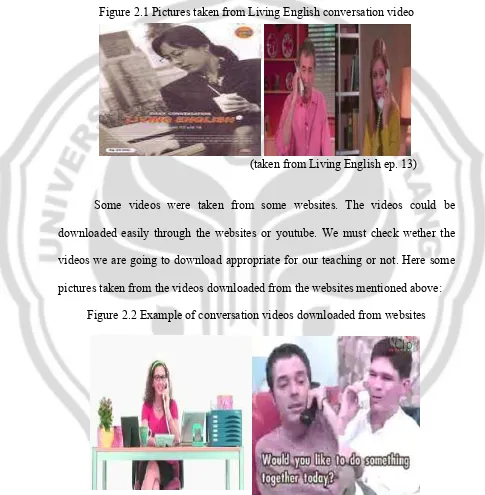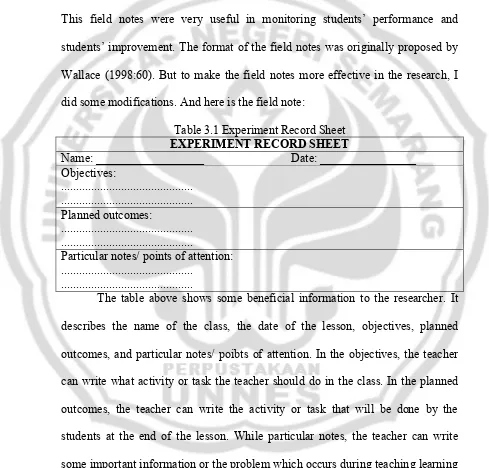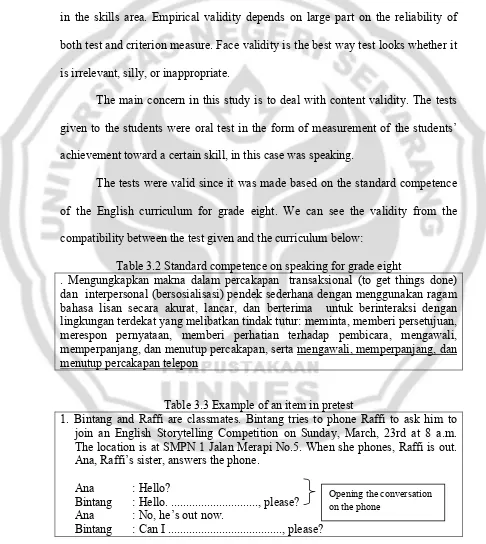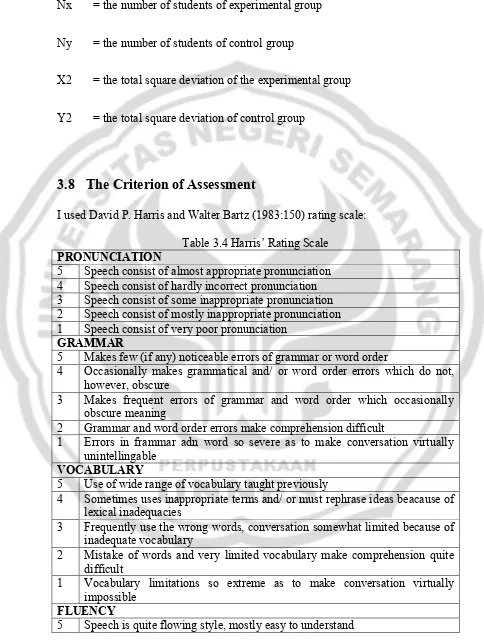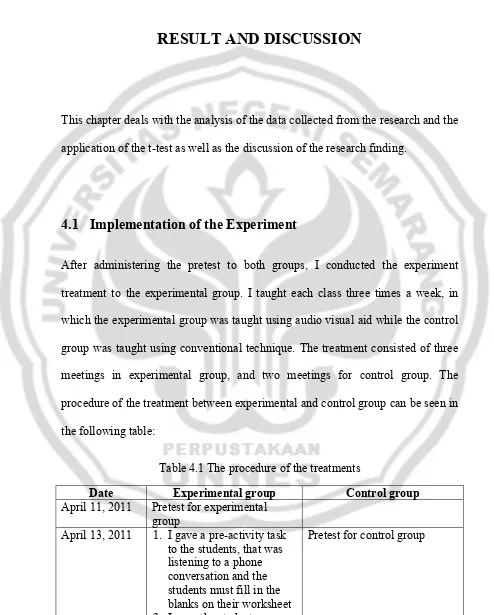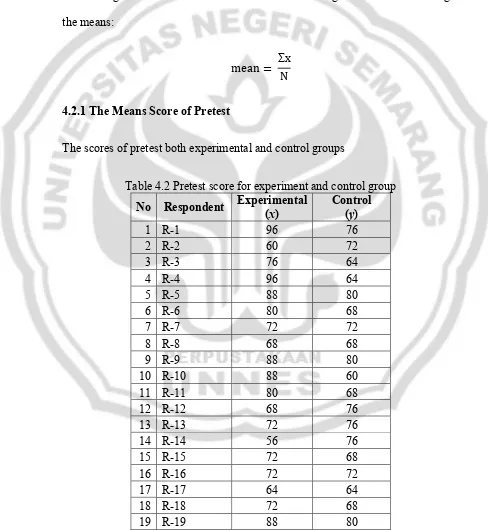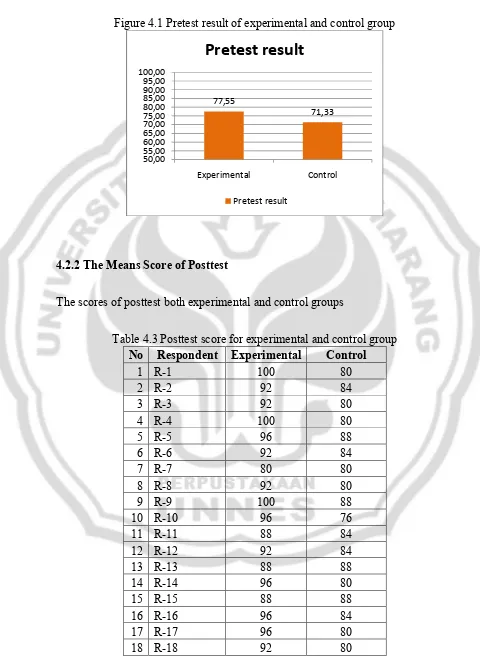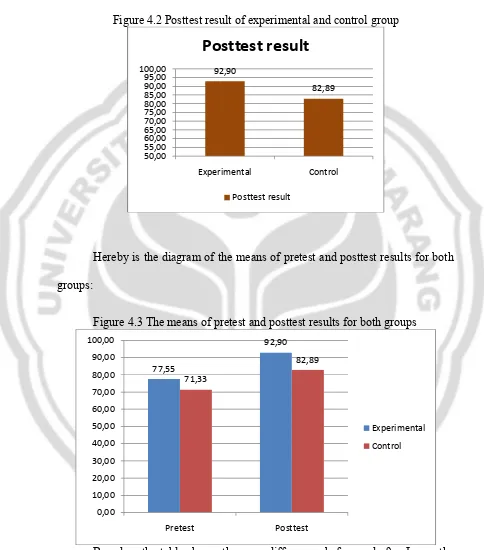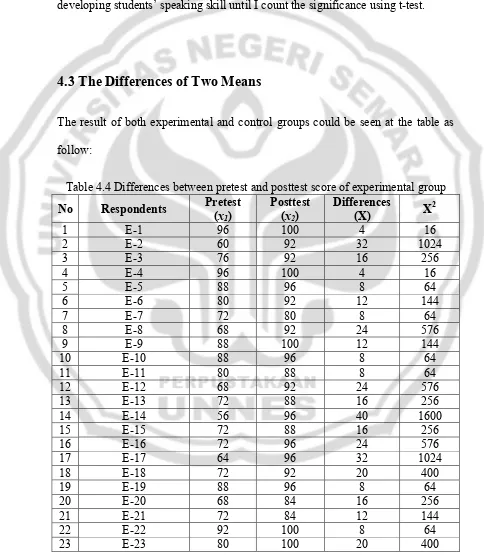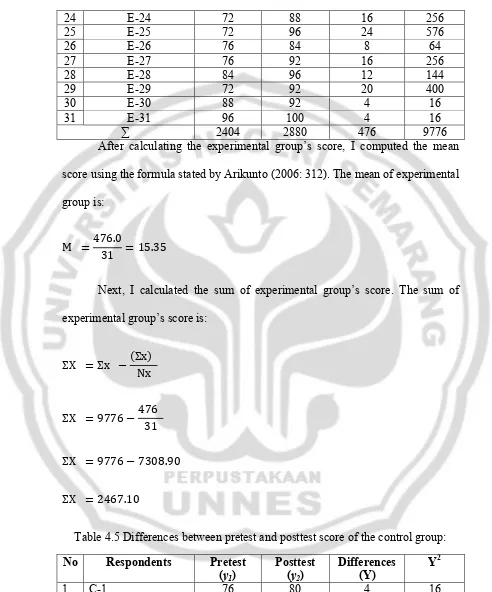i
(an experimental research at the eighth graders of SMP I Randublatung in the academic year of 2010/ 2011)
a final project
submitted in partial fulfillment of the requirements for the degree of Sarjana Pendidikan
in English
by
Pupuh Wulan Prasasti 2201407130
ENGLISH DEPARTMENT
FACULTY OF LANGUAGES AND ARTS
SEMARANG STATE UNIVERSITY
ii August 23, 2011.
Board of Examinations 1. Chairperson
Drs. Januarius Mujianto, M. Hum NIP 195312131983031002 2. Secretary
Dr. Dwi Anggani LB, M.Pd. NIP 195901141989012001 3. First Examiner
Drs. Suprapto, M.Hum. NIP 195311291982031002
4. Second Examiner as Second Advisor Drs. Ahmad Sofwan, Ph.D.
NIP 196204271989012001
5. Third Examiner as First Advisor Novia Trisanti, S.Pd.,M.Pd.
NIP 197611062006012002
Approved by
The Dean of the Faculty of Languages and Arts
iii
NIM : 2201407130
Program Studi : Pendidikan Bahasa Inggris Fakultas : Fakultas Bahasa dan Seni
Menyatakan bahwa skripsi/ final project berjudul: THE EFFECTIVENESS OF
USING AUDIO VISUAL AID IN TEACHING SPEAKING OF
INTERPERSONAL AND TRANSACTIONAL CONVERSATION (an
experimental research at the eighth graders of SMP I Randublatung in the academic year of 2010/ 2011)yang saya tulis dalam rangka memenuhi salah satu syarat untuk memperoleh gelar sarjana benar benar merupakan kerja sendiri yang saya hasilkan setelah melalui penelitian, bimbingan, diskusi dan pemaparan ujian. Semua kutipan baik langsung maupun tidak langsung, baik yang diperoleh dari sumber perpustakaan, wahana komputer, maupun sumber lainnya, telah disertakan keterangan mengenai identitas sumber dengan cara sebagaimana yang lazim dalam penulisan karya ilmiah. Dengan demikian, penulisan skripsi/ final project tetap menjadi tanggung jawab saya sendiri.
Semarang, Agustus 2011 Yang Membuat Pernyataan
iv
To:
My beloved parents
My beloved sister
v
First of all I would like to praise Allah SWT for the blessing and mercy to me during my study and in completing my final project .
I am grateful that during the completion of my final project, people surround me always support and help me to finish this final project well. I would like to express my sincere gratitude to Novia Trisanti, S.Pd., M.Pd. as the first advisor for giving me guidance and helps to finish the final project. I would like to extend my sincere thanks to Drs. Ahmad Sofwan, Ph.D. as my second advisor in improving my final project for its finalization.
Furthermore, I am grateful to all lecturers in English Department UNNES, for giving information, knowledge and suggestion for many years I studied in UNNES.
I would like to dedicate my deepest gratitude to my parents, Dulrochim and Lilis Setyowati, and my sister, Dian Purnaning Ratri, S.Pd. who always support me for my success. My family is all I have and the spirit in my life. I also would like to thanks Tyasa Regga Pratama, who always loves, cares, understands, and helps me all these years.
My friends and all people who always love me, thank you so much.
Semarang, Agustus 2011
vi
Teaching Speaking of Interpersonal and Transactional Conversations (an experimental research at the eighth graders of SMP 1 Randublatung in the academic year of 2010/ 2011). Final Project. English Department. Faculty of Languages and Arts. Semarang State University. Advisors: 1. Novia Trisanti, S.Pd., M.Pd., 2. Drs. Ahmad Sofwan, Ph.D.
Key words: Audio Visual Aid, Teaching Speaking, Interpersonal and Transactional Conversation
The topic of this study was the effectiveness of using audio visual aid in teaching speaking of interpersonal and transactional conversations (an experimental research of the eighth graders of SMP 1 Randublatung in the academic year of 2010/ 2011). The objectives of the study were to know the significant difference in students’ achievement in speaking between those who were taught using audio visual aid, especially conversation video, and those who were taught using conventional teaching method and to describe the improvement of students’ achievement in speaking of interpersonal and transactional conversations after being taught using audio visual aid especially conversation video in junior high school.
In order to achieve those objectives, I conducted an experimental research. The population of this study was the eighth graders of SMP 1 Randublatung. The experimental group was 8 A and the control group was 8 D. The experimental group was taught using audio visual aid, especially conversation video, while the control group was taught using conventional teaching technique.
vii
ABSTRACT... vi
TABLE OF CONTENTS... vii
LIST OF TABLES... x
LIST OF FIGURES... xi
LIST OF APPENDICES ... xii
CHAPTER I. INTRODUCTION 1.1 Background of the Study... 1
1.2 Reasons for Choosing the Topic ... 3
1.3 Research Questions ... 4
1.4 Objectives of the Study ... 5
1.5 Hypothesis ... 5
1.6 Significance of the Study ... 6
1.7 Outline of the Report... 7
II. REVIEW OF RELATED LITERATURE 2.1 Definition of Media ... 8
2.2 Audio Visual Aid ... 9
2.3 General Consideration of Speaking... 11
2.3.1 Language Competence in Speaking ... 12
2.3.2 Elements of Speaking... 12
viii
2.7 Interpersonal and Transactional Conversation in Speaking ... 19
2.8 Teaching Speaking Using Conversation Video ... 20
III. METHODS OF INVESTIGATION 3.1 Research Design ... 23
3.2 Population and Sample... 24
3.2.1 Population... 24
3.2.2 Sample ... 25
3.3 Research Variable ... 26
3.4 Instrument for Collecting the Data... 26
3.5 Procedure of Collecting the Data ... 28
3.6 Try out for the Instrument ... 28
3.6.1 Validity... 29
3.6.2 Reliability ... 30
3.6.3 Practicality... 31
3.7 Statistical Design... 32
3.8 The Criterion of Assessment ... 33
IV. RESULT AND DISCUSSION 4.1 Implementation of the Experiment... 35
4.2 Computation Between Two Means ... 39
ix
4.5 Discussion of Research Findings ... 50
4.5.1 The Statistical Interpretation ... 50
4.5.2 The Analysis of the Experiment... 51
V. CONCLUSION AND SUGGESTION 4.6 Conclusion... 53
4.7 Suggestions... 54
REFERENCES... 55
x
3.1 Experiment record sheet ... 27
3.2 Standard competence of speaking for grade eight ... 29
3.3 Example of an item in pretest ... 30
3.4 Harris’ rating scale ... 33
4.1 The procedure of the treatment ... 35
4.2 Pretest score for experiment and control group ... 39
4.3 Posttest score for experiment and control group... 41
4.4 Differences between pretest and posttest score of experimental group ... 44
xi
2.1 Pictures taken from Living English conversation video eps 13 ... 18
2.2 Example of conversation videos downloaded from websites ... 18
4.1 Pretest result of experimental and control groups... 41
4.2 Posttest result of experimental and control groups ... 43
xii
1. Lesson plan for experimental group... 59
2. Lesson plan for control group ... 64
3. Power point of the material... 68
4. Pretest... 70
5. Posttest ... 71
6. Handout for experimental group ... 72
7. Handout for control group ... 75
8. Experiment record sheet... 77
9. Pretest result of experimental group ... 80
10. Posttest result of experimental group... 81
11. Differences between pretest and posttest of experimental group ... 82
12. Pretest result of control group... 83
13. Posttest result of control group ... 84
14. Differences between pretest and posttest of control group ... 85
15. The test of significance between two means (t-test) ... 86
16. Conversation videos’ scripts ... 88
17. Pictures from the telephone conversation videos... 91
18. Documentation of students’ performance ... 92
19. Students’ worksheet ... 93
1
INTRODUCTION
This chapter is divided into seven subsections. They are background of the study, reasons for choosing the topic, research questions, objective of the study, hypothesis, significance of the study, and outline of the report.
1.1 Background of the Study
Language teaching plays an important role in education’s world. It prepares our generation to master the language well. By giving more explanation and chance to perform, it will improve students’ skill to learn language. As the realization of it, most of schools in every part of the world teach language especially English in order to prepare the students’ to compete in the world’s global communication era. Many educational experts are making every effort to make language teaching better.
The function of teaching English in junior high school is to reach the functional level that is the students are able to communicate in spoken and written form in order to solve the problems in their daily life. By studying English, the students are expected to have a mean to develop their knowledge of science, technology, and culture so that they can grow up with Indonesian personality (Depdiknas: 2000).
To use English correctly and appropriately, we need to learn many different things, since English is so much different from our native language. The differences can be seen in the grammar, the phonemes, the morphemes, and many others. Therefore, the major thing or purpose we learn English is that we can speak the language fluently and appropriately and also understandable.
Teaching speaking to students is a hard thing to do because to speak other than their native languages needs confidence and mastery of the foreign language. To speak English we need to know its grammar, vocabularies, culture, and many more. Here, it is teachers’ job to make their students have enough confidence to learn and to practice speaking English correctly and appropriately. Not only to practice it in the clasroom, but also in their daily activities and life.
Audio visual aid can be in form of movies, commercial breaks, video clips, short videos, and also conversation videos. Here, I will explore the use of conversation video in helping students in teaching learning activity. As we know, to hear and to see are different from only to hear and only to see. If the students are shown the real model of conversation, the pictures and the sounds, it will be easier for them to maintain the feel of the conversation.
We can find many conversation videos in many book stores. The publisher of those videos hope that this conversation video can be useful for the students in learning English. All the conversations in those videos used English. To make the situations more realistic, these videos also show the attitude, behaviour, and some habits in their life. The purpose of the video is to make students familiar with the situations and motivated to practice the conversation as shown in the video.
The audio visual aid is an effective media to improve students’ speaking skill since students can see and hear how the conversation should be done. Students can not only read and imagine how the native speakers or EFL students do the conversation. They can watch and imitate them so that their conversation can run smoothly and naturally.
1.2 Reasons for Choosing the Topic
students. In fact, the real model of conversation is definitely can help students to improve their ability in speaking, especially in daily conversation.
Since ITC model of learning has been applying in our country, to bring the real model of conversation is not a difficult thing anymore. Nowadays, there are plenty of CDs and other audio visual medias that can be used as a model for the students. The learning activity should include audio visual since this can be an effective way to improve students’ speaking skill of interpersonal and transactional conversations.
In this research, the teacher will use audio visual aid in form of conversation video in teaching speaking to see whether it helps the students in improving their speaking skill of interpersonal and transactional conversations. This research also will trigger teachers to apply audio visual aids in teaching speaking since it has more benefits toward students’ improvement of speaking skill.
1.3 Research Questions
Started from the general background of the study above, research questions can be stated as follows:
(2) How effective is the use of audio visual aid, especially conversation video, in teaching speaking of interpersonal and transactional conversation to the eighth grade students of SMP I Randublatung in the academic year of 2010/ 2011?
1.4 Objectives of the Study
(1) To find the significant difference in students’ achievement in speaking between those who were taught using audio visual aid, especially conversation video, and those who were taught using conventional teaching technique.
(2) To describe the improvement of students’ achievement in speaking of interpersonal and transactional conversation after being taught using audio visual aid, especially conversation video in junior high school.
1.5 Hypothesis
There are two hypotheses in this study. The first is the working hypothesis or the alternative hypothesis (H1). The alternative hypothesis in this study is: “There is a significant difference in students’ achievement in speaking between those who were taught using audio visual aid, especially conversation video, and those who were taught using conventional teaching technique.”
speaking between those who were taught using audio visual aid, especially conversation video, and those who were taught .
1.6 Significance of the Study
The result of this research can contribute some benefits to the readers:
(1) Teacher
I hope that teacher can use audio visual aids, especially conversation videos, in every possible situation so that students can learn how to speak by seeing the real model of conversation to be done. This can give ease to the teacher since this method applied less teacher talk and more explanation from the video which could be accepted easily to the students.
(2) Students
Students nowadays are audio visual learners, which means students will more understand the material if they listen and watch the real application of the material. By using audio visual aid, especially conversation video, in teaching speaking, students can get the real model of conversation so that they can learn how to speak naturally just like the native speakers do.
(3) English Department
University. This final project can provide the additional reference about using audio visual aid in teaching speaking for junior high school.
1.7 Outline of the Report
This final project is developed into five chapters. It begins with introduction on chapter one. It consists of background of the study, reasons for choosing the topic, statement of the problems, objective of the study, research hypothesis, significance of the study, and the outline of the research report.
The second chapter presents the review of related literature, which discusses about definition of media, audio visual aid, general consideration of speaking, definition of conversation, teaching speaking at Junior High School, interpersonal and transactional conversation in speaking, and teaching speaking using conversation videos.
The third chapter contains method of investigation including research design, population and sample, research variable, instrument for collecting the data, procedure of collecting the data, try out, statistical design, and the criterion of assessment.
Chapter four is data analysis and interpretation which consists of the extent of using audio visual aid to help students improving their speaking skill of interpersonal and transactional conversation.
8
This chapter will give the definition and the explanation of each parts of the title. Those parts are definition of media, audio visual aid, general consideration of speaking, the definition of conversation, teaching speaking at junior high school, interpersonal and transactional conversations in speaking, and teaching speaking using conversation videos.
2.1 Definition of Media
According to Hornby (1995: 727), media are the main means of communicating with large number of people, especially television, radio, and newsapaper, as the mass media.
While Gagne (1983: 4) states that media are kinds of component in the surrounding around students which stimulate them to study. Briggs (2002: 147) argues that media are all physical tools which serve messages and make stimuli towards students to study, like book, film, cassette, and so on.
2.2 Audio Visual Aid
Audio visual means something that can bee seen and can be heard. The term audio visual aids refers to anything that a teacher uses to help facilitate communication of the learning material when he interacted with the students (Campbel, K.L.I., et al: 2006). The brand new innovation of audio visual aid is video. According to Harmer (2002: 282), there are many reasons why video can add a special extra dimension to the learning experience: (1) Seeing language in use: one of the main advantages of video is that students do not just hear language but they can see it too; (2) Cross cultural awareness: video uniquely allows students to look at situations beyond their classroom. This is especially useful if they want to see, for example, typical British “body language” when inviting someone out, or how Americans speak to waiters. Video is also great value in giving students a chance to see such things as what kind of food people eat in other countries and what they wear; (3) The power of creation, when students use video cameras themselves they are given the potential to create something memorable and enjoyable. The camera operators and directors suddenly have considerable power. The task of video making can provoke genuinely creative and communication uses of language, with students finding them “doing new things in English”; (4) Motivation: for all reasons so far mentioned, most students show an increased level of interest when they have a chance to see language in use as well as hear it, and when this is cup led with interesting tasks.
(1) Content
Do the mdia i.e. video have significatnt selection with lesson? The chosen of certain media must be confirmed to the lesson (message) to be given to the students.
(2) Purposes
The use of audio visual aids should contribute the teaching learning process significantly. It means that media can facilitate the teaching learning process.
(3) Price
Before buying certain visual aids a teacher should consider whether the cost or money is in accordance with the educational result derived from its use.
(4) Circumtances of use
In choosing an audio visual aid, a teacher should take account the environment (school) where he teaches. He should think whether the aid world function especially in that environment.
(5) Learner’s verification
A teacher should think whether the aid has been tested to certain students, he or she could consider if the tested students are similar to the students whom she or he teaches.
(6) Validation
2.3 General consideration of speaking
Speaking is a social skill. As a sophisticated skill, speaking, which many people may also known as oral skill, is the product of creative construction of linguistic strings, the speaker make choices of lexicon, structure, and discourse (Brown, 2004:140). Whereas one can read and write in private or listen to the radio or watch television alone, a person rarely speaks without an audiance of some sort. Communication being the goal of second language program, emphasis is placed on the development of correct speech habits.
Fulcher (2003: 23) states that speaking is the verbal use of language to communicate with others. The purposes for which we wish to communicate with others are so large and so it is not possible to discuss all in section. Speaking is more than pronunciation and intonation. At the functional level, speaking is making oneself understood. At a more refined level, speaking requires the correct and idiomatic use of the target language.
2.3.1 Language Competence in Speaking
Phonology : pronunciation, stress, intonation Accuracy : syntax, vocabulary, cohesion
Fluency : hestitation, repetition, reselecting inappropriate words, restructuring sentences, cohesion.
2.3.2 Elements of Speaking
The ability to speak fluently requires not only knowledge of language features, but also the ability to process information and language on the spot. According to Harmer (2001: 269) the elements necessary for spoken production are the following:
(1)Connected speech
Speaking English can run effectively if the speakers are able to both produce the individual phonemes of English and use fluent “connected speech”. In connected speech, sounds are modified, omitted, added, or weakened. For this reason, involving students in activities design especially to improve their connected speech should be done.
(2)Expressive devices
Native speakers of English change the pitch and stress of particular parts of utterances and speed, and show by the other physical and non-verbal means how they are feeling. The use of these devices contributes to convey meanings. They allow an extra expression of emotion and intensity.
Spontaneous speed is marked by the use of a number common lexical phrases, especially in nthe performance of certain language function. Teacher should therefore supply a variety of phrases for different functions such as agreeing, disagreeing, expressing surprises, shock, and approval. When the students are involved in specific speaking contexts, they can primed, in the same way with certain useful phrases, which they can produce at various stages of an interaction.
(4)Negotiation language
Effective speaking benefits from the negotiator langauge that attempts tro seek clarification and to show the structure of what they are saying.
From the elements of speaking mentioned above, I can conclude that there are at least five elements of speaking that are used to assess, among others are fluency, pronunciation, grammar, vocabulary and content.
2.4 Teaching Speaking at Junior HighSchool
According to the School Based Curriculum, junior high school students are in the functional level of literacy in which they are able to solve their problems (KTSP 2007:277).
language and english is not used outside the classroom, present additional challenges for the teacher”. Thus, the students need teachers’ guidance in learning speaking. Class activity organization that is authentic, motivating, and varied need to be considered by the teacher. Many techniques then should be used in teaching speaking so that students can learn the language better.
2.5 The Definition of Conversation
A conversation is communication between multiple people. It is a social skill that is not difficult for most individuals (http://en.wikipedia.org/wiki/conversation). Conversations are the ideal form of communication in some respects, since they allow people with different views on a topic to learn from each other.
2.5.1 Classification of Conversation
Conversation can be classified based on some points (http://en.wikipedia.org/wiki/ conversation), they are:
(1) Subject
The majority of conversations can be divided into four categories according to their major subject content: (a) conversation about subjective ideas, which often serve to extend understanding and awareness; (b) conversation about subjective facts, which may serve to sonsolidate a widely-held view; (c) conversation about subjective facts, which may serve to sonsolidate a widely-held view; (d) conversations about other people (usually absent), which may be critical, competitive, or supportive; (e) conversation about oneself, which indicate attention-seeking behavior. In the real world, few conversations fall exclusively into one category. Nevertheless, the proportional distribution of any given conversation between the categories can offer useful psychological insights into the mind set of the participants.
(2) Function
usually between friends, which may rely on humor on in-jokes at the expense of those taking part. The purpose of banter may at first appear to be an offensive affront to the other person’s face. However, people engaging in such conversation are often signaling that they are comfortable enough in each other’s company to be able to say such things without causing offense. Banter is particularly difficult for those on the autism spectrum, or those with semantic pragmantic disorders.
(3) Spontaneity
In most conversation, the responses are a spontaneous reaction to what has previously been said. In infotainment talk show, however, the topic of conversation is often pre-scripted.
(4) Men and women
A study completed on July 2007 by Mattias Mehl of the University of Arizona shows that contrary to popular belief, there is a little difference in the number of words used by men and women in conversation. The study showed that on average each of the sexes uses about 16,000 words per day.
2.6 Conversation Video
application of conducting the conversation with the help of video and the model recorded on it.
Amien and Lamere (2009:6) state that there are many advantages of using conversation video in teaching speaking especially for EFL students; among them are:
(1) as an audio visual media, conversation video can give students extra comfort where they can see and hear the conversation to be conducted
(2) all the topics can be displayed in one single shot and in only few minutes; unlike book that the topics should be read in pages and also takes more time (3) video can add emotional impact to readers so that students can really feel how
the expressions, intonations, and emotions of the speakers when they uttered the sentences
(4) it demonstrates how the body movement of the speakers when they have a talk, and
(5) students can directly imitated the conversation conducted on the video as they are already recognize the emotion and the body movement of the speakers in the video
translation and one is with translation. The video is easy to understand since the instructors speak clearly. Here is a picture taken from Living English conversation video:
Figure 2.1 Pictures taken from Living English conversation video
(taken from Living English ep. 13)
Some videos were taken from some websites. The videos could be downloaded easily through the websites or youtube. We must check wether the videos we are going to download appropriate for our teaching or not. Here some pictures taken from the videos downloaded from the websites mentioned above:
Figure 2.2 Example of conversation videos downloaded from websites
2.7 Interpersonal and Transactional Conversation in Speaking
There are wide events in which we use speaking skill in our daily life, it can be speech, reading powm, reporting news, and delivering ceremonial event. However, the speaking activity people must get involved in is conversation, a dialogic communication between tow or more participants. As we use it in everyday of our life, we can call conversation as a basic speaking activity human have.
School Based Curriculum (2007:277) mentiones that there are two kinds of conversations the students of junior high school should learn. They are interpersonal and transactional conversation. Interpersonal conversation lies its function for social purposes. Greetings, apologies, compliments, invitations, and other functions are the example of functions in this conversation. Meanwhile, transactional conversation holds transactional exchanges people usually involved in activities such as obtaining information and making purchase.
Since this study is majoring transactional conversation, we will focus our discussion in this area only. Transactional conversation is a basic speaking activity in our daily life. Take for example, everyone must need help from other people and, on the contrary, we sometimes are eager to help the others. Therefore, learning transactional conversation is important since we use it in our daily life. By learning transactional conversation the students are expected to be able to interact with their closest environment.
taking, negotiation, correction, and other technical term. Therefore, teaching transactional conversation to the students should include such things, besides vocabularies and purpose of the speaking.
2.8 Teaching Speaking Using Conversation Video
The use of media in teaching is very essential since the teaching and learning process can run more productively, make the teacher opens a new paradigm to the students, and also build a new atmosphere in the classroom (Danim: 1995).
One of the most popular media used among the teacher is video. For teacher of English, the kind of video most commonly used is conversation video. Nowadays there are plenty of CDs available for EFL students. The CDs contains various types of materials so that teacher can choose which one meets the needs of his students. Besides CDs, teachers and students can get the conversation video from the web. Nowadays many people around the world create and share this kind of video to help EFL students to master English conversation.
When the teacher uses video in teaching, he can devide the teaching and learning process into three steps; watch, learn, and play (Walker: 1997). On the first step, teacher plays the conversation video contains a certain topic according to today’s agenda. Students watch and pay a close attention to the conversation on the video. After watching the video one or two times, students will understand the flow and the content of the conversation. Also, they will recognize the appropriate pronunciation and intonation. The next step is the learn process. Here, teacher explains what is the video about and the objective of showing the video to the students. Teacher also explains about the vocabularies, expressions used in the conversation, the intonations, the pronunciation, and the grammatical matters in the video. Since students have watched the video previously, it is not difficult for them to recognize and understand teacher’s explanation. after explanation done, it is the time for real application of the conversation. Teacher asks students to make a similar dialogue with their friends, with the same or different situations as in the conversation video. Students can explore their dialogue by using the expressions given by the teacher, not only copying from the conversation video. Students will play their dialogue in front of the class, with appropriate pronunciation and intonation, and also the right gesture for some expressions (Walker:1997).
23
E 01 X 02
C 03 Y 04
This chapter discusses research design, population and sample, research variable,
instrument for collecting the data, procedure of collecting the data, try out for the
instrument, statistical design, and the criterion of assessment.
3.1 Research Design
This research used experimental design, that is by collecting data with treatment
using pretest-posttest design. Best (1981:68) states that “experimental research is
the blueprint of the procedures that enable the researcher to test hypothesis by
reaching valid conclusion about relationship between dependent and independent
variable”. The design of the experiment can be described as the following :
(Arikunto, 2002:79)
Where:
E : Experimental group
C : Control group
01 : Pre-test for the experimental group
02 : Post-test for the experimental group
04 : Post-test for the control group
X : Treatment using audio visual aid
Y : Treatment using conventional teaching technique
In the design above, the subject of the research was assigned to the
experimental group (top line) and the control group (bottom line). First, the
quality of the subject was checked by giving them pretest (01 and 03), then the
experimental treatment was performed to the experimental group, while the
control group was taught using conventional teaching technique. Then post test
was conducted to both groups and then the results were computed statistically.
This method is simply called pretest posttest equivalent groups.
3.2 Population and Sample
The descroption of the population, sample, as well as sampling technique are as
follows:
3.2.1 Population
Margono (2003:18) defines population as a complete set of individuals or subjects
having common observable characteristics. In addition, Saleh (2001: 17), argues
that population is a group of people, object, items, or phenomenon, a group which
the researcher would like the results of the study to be generalized, a group from
which information is collected.
In quantitative research, the researcher attempts to discover something
about a large number of groups of individuals by studying a much smaller group.
The population used to conduct the observation in this study was the
students of grade eight of SMP N 1 Randublatung in the academic year of 2010/
2011.
3.2.2 Sample
Sample is a representative of population which acts for the population and reflect
the condition of population. According to Gall M.D (2003: 167), sampling refers
to this process of selecting a sample from a defined population with the intent that
the sample accurately represents that population. This process refers to the
quantitative research. Therefore, in order to know the effectiveness of the topic,
taking two classes had been done.
In grouping the subjects, I used purposive sampling. It is the one which is
the person who is selecting the sample is who tries to make the sample
representative, depending on his opinion or purpose, thus being the representative
subjective. That was by picking a group with the same background knowledge
level of the topic given. Then I decided class VIIIA as the experimental group and
VIIID as the control group. Comparing their result of speaking of interpersonal
and transactional conversation where one class used audio visual aid and the other
one did not use it was the next step. The first group was the experimental group
and the second one was the control group.
3.3 Research Variable
Variable is the condition as characteristics that a researcher manipulates, controls,
and dependent variable (Y). The independent variable is a stimulus variable or
input that affects behavior (of dependent variable); whereas the dependent
variable is a response variable or output. Thus, the independent variable (X)
affects the dependent variable (Y)
In the context of this research, the independent variable (X) was using
audio visual aid in teaching speaking, and the dependent variable (Y) was the
improvement of students’ achievement in speaking of interpersonal and
transactional conversation.
3.4 Instrument for Collecting the Data
Instrument is an important device to collect data in a research program. As stated
in Saleh (2001: 17), instrument refers to some short hand devices for observing
and recording events of for gathering data. In addition, Arikunto (2002: 210)
argues that research instrument is a device used by the researcher while collecting
data to make his work become easier and to get better result, complete and
systematic in order to make the data easy to process.
(1) Tests
Brown (2004:3) said that the term test is a method of measuring a person’s ability,
knowledge, or performance in a given domain. I used oral test in my investigation.
The purpose of giving test was to measure students’ achievement in speaking. The
test will be in the form of oral test and there were pre-test and post-test for each
group. The pre-test was used to check students’ speaking ability in speaking. The
interpersonal and transactional conversation had been improved after the
treatment. The complete pretest and posttest can be seen in appendix 4 and 5.
(2) Field notes
In this study, I took notes during the teaching learning activities in the classroom.
This field notes were very useful in monitoring students’ performance and
students’ improvement. The format of the field notes was originally proposed by
Wallace (1998:60). But to make the field notes more effective in the research, I
did some modifications. And here is the field note:
Table 3.1 Experiment Record Sheet
EXPERIMENT RECORD SHEET
Name: __________________ Date: ________________ Objectives:
... ... Planned outcomes:
... ...
Particular notes/ points of attention: ...
...
The table above shows some beneficial information to the researcher. It
describes the name of the class, the date of the lesson, objectives, planned
outcomes, and particular notes/ poibts of attention. In the objectives, the teacher
can write what activity or task the teacher should do in the class. In the planned
outcomes, the teacher can write the activity or task that will be done by the
students at the end of the lesson. While particular notes, the teacher can write
some important information or the problem which occurs during teaching learning
3.5 Procedure of Collecting the Data
In this study, in order to collect the data, some steps were applied, they were:
(1) Choosing eighth graders of SMP N 1 Randublatung as the population
(2) Taking two groups from the population and dividing them into two
groups; experimental and control group
(3) Administering pretest for both groups
(4) Conducting the research
For the experimental group, I used audio visual aid especially conversation
video in teaching speaking of interpersonal and transactional conversation.
For the control group, I used conventional technique in teaching speaking
of interpersonal and transactional conversation.
(5) Administering post-test for both groups
(6) Analyzing the result
3.6
Try Out for the Instrument
Harris (1969:13) said that all good tests possessed three qualities, they are:
validity, reliability, and practicality. That is to say, any test we had to use
appropriate, in item of our objectives, dependable in the evidence provides and
applicable to our particular situation. Since the tests given to the students were
oral tests, it was not necessary to use computation in validity, reliability, and
practicality. Here, I tested the validity, reliability, and practicality using informal
way, that were by consulting the tests to the teachers of both classes and checking
3.6.1 Validity
Validity referred to the precisely measurement of the test. There are three kinds of
validity, they are: content validity, empirical validity, and face validity. Content
validity means the test reflects an analysis according to the views of recognizing
in the skills area. Empirical validity depends on large part on the reliability of
both test and criterion measure. Face validity is the best way test looks whether it
is irrelevant, silly, or inappropriate.
The main concern in this study is to deal with content validity. The tests
given to the students were oral test in the form of measurement of the students’
achievement toward a certain skill, in this case was speaking.
The tests were valid since it was made based on the standard competence
of the English curriculum for grade eight. We can see the validity from the
compatibility between the test given and the curriculum below:
Table 3.2 Standard competence on speaking for grade eight
. Mengungkapkan makna dalam percakapan transaksional (to get things done) dan interpersonal (bersosialisasi) pendek sederhana dengan menggunakan ragam bahasa lisan secara akurat, lancar, dan berterima untuk berinteraksi dengan lingkungan terdekat yang melibatkan tindak tutur: meminta, memberi persetujuan, merespon pernyataan, memberi perhatian terhadap pembicara, mengawali, memperpanjang, dan menutup percakapan, serta mengawali, memperpanjang, dan menutup percakapan telepon
Table 3.3 Example of an item in pretest
1. Bintang and Raffi are classmates. Bintang tries to phone Raffi to ask him to join an English Storytelling Competition on Sunday, March, 23rd at 8 a.m. The location is at SMPN 1 Jalan Merapi No.5. When she phones, Raffi is out. Ana, Raffi’s sister, answers the phone.
Ana : Sure. What is it?
Bintang : ... Ana : ... Bintang : Thanks. Good bye.
Ana : Bye.
The test given to the students were about telephone conversation, so the
tests were in line with the existing curriculum.
3.6.2 Reliability
Reliability is a general quality of stability of scoring regardless of what the test
measured.
Brown (2004:20-22) states that there are some factors in considering one
test could be said reliable or not, they are fluctuations in the students, in scoring,
in test administration, and in the test itself.
The students’ condition takes the most part in deciding whether a tets is
reliable or not. Sometimes students are sick, has fatigue, has bad days, or other
physical and psychological factors which may obstract one’s from achieving his
true score. Next is the scoring system. This could be in the form of inter-rater
reliability or intra-rater reliability. Inter-rater reliability occurs when two or more
scorers yield inconsistent acores of the same test (Brown: 2004, 21). And
intra-rater reliability is a common occurance for classroom teachers because of unclear
scoring cirteria, bias toward good and bad students, or simple carelessness.
The condition in which the students take the test could be also affect the
reliability of a test. The test must be administered in a very proper and
comfortable place in which students can do the test well. Also the last factor is the
test itself. The test made must be appropriate to the students’ background
knowledge, to the time allotment, and to the criteria of scoring.
Extending the conversation on the phone
Based on the observations of the tests, the tests given to the test takers
were reliabe since there were a certain criteria in achieving each points. The
criteria can be seen in point 3.8 in this chapter, table 3.4. Nevertheless, there were
some occurances in discussing scoring criteria. This happened because I was still
having a lack experience in scoring students’performance and also from the
teacher themselves that having different point of view in deciding which students
achieve what criteria. Sometimes the score given by each scorers were a bit
different. Nevertheless, by discussing and analyzing the recording of the
performance once more, the difference could be erased.
3.6.3 Practicality
A test must be applicable to our particular situasion. It almost the same as the
factors of the reliability for a test, which a test must be achievable to all test
takers, not only the high-rank test takers, for example. And also a test must be
easy to be administered to the test-giver.
The tests given to the students were applicable in the classroom, and could
be administered witout any obstacles. The students were also did not face much
difficulty in doing the test. Proven by their scores which were above expectation.
3.7 Statistical Design
Brown (1998:116-117) points out that statistics is made calculation to describe a
sample. If the same calculations are actually done for the entire population he
adds, they would be called parameters. Brown concludes that there are always
other words, the results are in error, and that is why we need the probability called
the alpha level level of significance. Brown suggests is set at 5 percent (0,05),
which means that the probability of error in rejecting the null hypothesis is 5 in
100.
The calculations needed for statistical analysis were as follow:
First, I scored the result of the test of experimental group and control
group based on the speaking component and added them to get the total number.
Second, I counted the mean of the test result of the group. The formula
was:
∑x = the total number of the test
N = the number of the students
The third, I analyzed the data by using t-test. I used the t-test to know the
effectiveness of audio visual aid in teaching speaking of transactional
conversation. The formula of the t-test is as follow:
Mx = the mean score of experimental group
Nx = the number of students of experimental group
Ny = the number of students of control group
X2 = the total square deviation of the experimental group
Y2 = the total square deviation of control group
3.8 The Criterion of Assessment
I used David P. Harris and Walter Bartz (1983:150) rating scale:
Table 3.4 Harris’ Rating Scale
PRONUNCIATION
5 Speech consist of almost appropriate pronunciation 4 Speech consist of hardly incorrect pronunciation 3 Speech consist of some inappropriate pronunciation 2 Speech consist of mostly inappropriate pronunciation 1 Speech consist of very poor pronunciation
GRAMMAR
5 Makes few (if any) noticeable errors of grammar or word order
4 Occasionally makes grammatical and/ or word order errors which do not, however, obscure
3 Makes frequent errors of grammar and word order which occasionally obscure meaning
2 Grammar and word order errors make comprehension difficult
1 Errors in frammar adn word so severe as to make conversation virtually unintellingable
VOCABULARY
5 Use of wide range of vocabulary taught previously
4 Sometimes uses inappropriate terms and/ or must rephrase ideas beacause of lexical inadequacies
3 Frequently use the wrong words, conversation somewhat limited because of inadequate vocabulary
2 Mistake of words and very limited vocabulary make comprehension quite difficult
1 Vocabulary limitations so extreme as to make conversation virtually impossible
FLUENCY
4 Speed of speech seems to be slightly affected by language problems 3 Speed and fluency are strongly affected by language problems 2 Usually hestitate: often forced into silence by language limitation
1 Speech is to halting and fragmentary as to make conversation virtually impossible
CONTENT
5 Ideas highly organized, covers all of the elements of the story 4 Ideas well organized, covers almost all of the elements of the story 3 Ideas less organized, some missing parts of the elements of story 2 Ideas less organized, covers only the main elemnts of the story 1 Unorganized ideas, a lot of missing parts of the elements
Total score = 25
Modified from Harris (1969:84) and Walter Bartz (1983:150)
Then the scoring system used this formula:
Final score = total score x 4
For each components, the maximum score is 5. After summing all the score in
each point, then it is multiply by four to get the final score. The maximum final
score for each student is 100. And the minimum score is 25.
For example, students A get 3 for each components. Then his total score is 15.
35
This chapter deals with the analysis of the data collected from the research and the
application of the t-test as well as the discussion of the research finding.
4.1 Implementation of the Experiment
After administering the pretest to both groups, I conducted the experiment
treatment to the experimental group. I taught each class three times a week, in
which the experimental group was taught using audio visual aid while the control
group was taught using conventional technique. The treatment consisted of three
meetings in experimental group, and two meetings for control group. The
procedure of the treatment between experimental and control group can be seen in
the following table:
Table 4.1 The procedure of the treatments
Date Experimental group Control group
April 11, 2011 Pretest for experimental group
April 13, 2011 1. I gave a pre-activity task to the students, that was listening to a phone conversation and the students must fill in the blanks on their worksheet 2. I gave the students a
handout containing script of the conversation video I played for them later. 3. I played the conversation
in a whole first, but then when I played the video for the second time, I paused the video whenever I feel like to explain the expressions or pronunciations to the students.
4. After playing the video twice times, I explained the expressions used in the video. The video showed how to leave a message to a person.
5. When the time was almost up, I gave the students an assignment, that is to make a similar dialog just like in the video, using different situation and person.
April 14, 2011 1. I gave a pre-listening activity o the students while checking wether they were still remember last meeting’s material or not.
2. I reviewed last meeting’s material in questions and answers session.
3. I played the conversation in a whole first, but then when I played the video for the second time, I paused the video whenever I feel like to explain the expressions or pronunciations to the students.
4. After playing the video twice times, I explained the expressions used in the
1. I gave a handout to the students containing todays material, about phone conversation.
2. I explained the expressions for opening, extending and closing telephone
conversation.
3. I gave the example to the students.
4. I made the students perform the example in front of the class.
video. The video showed how to make an
appointment.
5. When the time was almost up, I gave the students an assignment, that is to make a similar dialog just like in the video, using different situation and person.
April 16, 2011 1. I reviewed students’
assignments while checking students’ mastery in the material.
2. I explained the material that day, that was making appointment by phone, to the students.
3. I gave the example to the students.
4. I made the students perform the example in front of the class.
5. After several performances, I gave an assignnment to the students, that was making a similar dialog as in the example dialog only using different situations. April 18, 2011 1. I reviewed last meeting’s
materials by discussing students’ previous assignment.
2. I played the conversation video in a whole first, but then when I played the video for the second time, I paused the video
whenever I feel like to explain the expressions or pronunciations to the students.
how to make an appointment.
4. When the time was almost up, I gave the students an assignment, that is to make a similar dialog just like in the video, using different situation and person.
April 20, 2011 Posttest for the eperimental group
Posttest for the control group
The experimental group had three times treatment. In each treatment, the
students were given different conversation videos. Each conversation video
contained different material. The three steps learning (watch, learn, and play) was
used in the treatment. Students paid a close attention to the video, listened and
recognized the correct intonation and pronunciation from the video. after that I
explained various kinds of expressions depend on the material, to the students.
After that students did the roleplay in front of the class using their own dialog.
Meanwhile, control group only had two times treatment. The materials
given to the students were similar to experimental group. Only control group was
taught without using conversation video. They only had a handout and my
explanations as the media in learning. Although the students were also understand
the material well, their pronunciation, intonation, and overall performance were
unlike the experimental group. Experimental group’s performance was better
because they had seen the real model of convrsation so that thay can learn many
things at the same time, there were pronunciation, intonation, and gesture. The
control group had not gotten such real model of the conversation, so they
4.2 Computation between Two Means
After getting all the test scores, the computation was made. The first way to know
the significant difference of the experimental and control groups’ score could be
seen through the difference of the means. The following formula was used to get
the means:
mean = Σx N
4.2.1 The Means Score of Pretest
The scores of pretest both experimental and control groups
Table 4.2 Pretest score for experiment and control group
20 R-20 68 80
After tabulating the pretest scores of experimental and control group, the
means can be computed as follows:
Mean score of experimental group:
Figure 4.1 Pretest result of experimental and control group
4.2.2 The Means Score of Posttest
The scores of posttest both experimental and control groups
Table 4.3 Posttest score for experimental and control group
19 R-19 96 80
control groups can be computed as follows:
Hereby is a diagram of the means score of posttest:
Figure 4.2 Posttest result of experimental and control group
Hereby is the diagram of the means of pretest and posttest results for both
groups:
Figure 4.3 The means of pretest and posttest results for both groups
Based on the table above, there are differences before and after I gave the
students different treatments. If we compare the two means, it is clear that the
mean of the experimental group’s posttest was higher than the control group. The
difference between the two means is (Mx-My). It indicated that the use of audio
visual aid were effective in improving students’ speaking skill especially in daily
conversation. Hence, I still cannot claim that the method I used is effective in
developing students’ speaking skill until I count the significance using t-test.
4.3 The Differences of Two Means
The result of both experimental and control groups could be seen at the table as
follow:
Table 4.4 Differences between pretest and posttest score of experimental group
24 E-24 72 88 16 256
score using the formula stated by Arikunto (2006: 312). The mean of experimental
group is:
Table 4.5 Differences between pretest and posttest score of the control group:
5 C-5 80 88 8 64
using the formula stated by Arikunto (2006: 312). The mean of control group is:
M =416.0
36 = 11.56
Next, I calculated the sum of control group’s score. The sum of control
ΣY = Σy −(Σy) Ny
ΣY = 5632−416.0 36
ΣY = 5632−4807.11
ΣY = 824.89
To make the analysis more reliable, I analyzed by using t-test formula as
stated in chapter III.
4.4 Test of Significance
As mentioned above, the mean of control group was lower than the mean of the
experimental group. Nevertheless, I could not infer that the difference between the
two means was significant. Hence, I applied t-test formula. T-test was used to
check whether the two means were statistically significant or not. Here is the
formula:
t = Mx−My ΣX +ΣY Nx + Ny−2
1 Nx+
1 Ny
Where :
Mx = the mean score of experimental group
Nx = the number of students of experimental group
Ny = the number of students of control group
X2 = the total square deviation of the experimental group
Y2 = the total square deviation of control group
t = Mx−My
ΣX +ΣY Nx + Ny−2
1 Nx+
1 Ny
Where:
ΣX =Σx −(Σx) Nx
ΣX = 9776−476 31
ΣX = 9776−7308.90
ΣX = 2467.10
And
ΣY =Σy −(Σy) Ny
ΣY = 5632−416.0 36
ΣY = 5632−4807.11
So the t value could be computed as follow:
As suggested by Best (1981), “for subjects which require fixed computation
such as mathematics and physics the 1 percent (0.1) alpha level of significance
can be used. Whereas the psychology and educational cycles the 5 percent (0.5)
alpha level of significance can be used.” So, I used the 5 percent (0.5) alpha level
of the significance.
The number of the subjects from both control and experimental group was
67, so the degree of freedom was 65, which were obtained from:
∑Nx+∑Ny-2. For 5 percent (0.5) alpha level and 65 degree of freedom was no
definite critical value in the t-table. It was needed to find the definite value using
40−65 65−60=
1.684−t t−1.671 t = 1.67
The critical t-value was 1.67. The obtained t-value from the t-test
calculation above was 2.18. Therefore, it could be shown that the obtained
t-value was higher than the critical t t-value. It could be inferred that there was
significant difference between experimental and control group.
4.5 Discussion of Research Findings
The research finding should not only be in the form of quantification. The result
of the study should be interpreted, as well as the teacher’s notes from
experimental record sheet.
4.5.1 The Statistical Interpretation
From the result of statistical analysis by using t-formula, it shows that the result is
2.18. When the result of t-value is compared to t-table on the level significance of
5% and the number of degree freedom is 65, which the result is 1.67, the
comparison shows that the result of t-value is higher than t-table.
Since the result of t-value is higher than t-table, null hypothesis (Ho) is
refused, while alternative hypothesis (H1) is accepted. From the result, it could be
concluded that there is significant different between experimental class and
By comparing the result of t-value and t-table, so the hypothesis (H1):
“There is a significant difference in students’ achievement in speaking between
those who were taught using audio visual aid, especially conversation video, and
those who were taught using conventional teaching technique.”
4.5.2 The Analysis of the Experiment
Generally, teaching speaking using audio visual aids are common for students
nowadays. Since teachers and students nowadays are familiar with technology,
and also the form of learning aids are numerous and various. For schools in the
vilage such as SMP 1 Randublatung, the use of technology gives new paradigm in
teaching. Students are not only studying through books and papers given by their
teahcer, but they are also can get more knowledge through technology.
As I did my experiment in SMP 1 Randublatung, I noted that when the
students were taught using audio vidual aids, in this case conversation videos,
they became more interested in the lesson than when I only discussed the material
using conventional technique. The control group sometimes distracted by the
noise of their friends outside the classroom since their attention were only focuses
on listening to my explanation. While the experimental group, since the teaching
and learning process were in the language laboratory, the students could be more
concentrate in joining the classes. In addition, to understand the videos well,
students must concentrate on both listening and watching the videos so that they
focused on the videos more. To listen and to watch proved to improve
students’concentration span so that their achievement were higher than the control
Eventhough using audio vidual aids, in this case conversation videos, was
proven effective enough in teaching speaking for daily conversation, it did not
mean that using conventional technique was not effeectvie. The characteristics of
students that always curious about new things and new development for their
learning I think influence students to achieve higher score most. This also did not
mean that the application of using audio visual aids always runs smooth. There
were some obstacles in applying this method as well. First, the electricity that
often black out duirng the lesson. Unlike in big cities, black out are often happen
in the village. So teachers who are using technology and electricity in teaching
must always anticipate this condition. As I experienced, to anticipate the black out
that happen suddenly, I prepared a handout for the students containing the
pictures and dialogues from the videos, and also an electronic dictionary, so that
when there was a black out, students can perform the dialogue with proper
pronunciation consulting the dictionary by themselves. Second, the hysteria of
students knowing that they will be taught using audio vidual aids was another
obstacle in applying this method. Students sometimes got too excited in the
classroom so that they could not hear the conversation well. However, those
obstacle were not a big problem that the teaching and learning process could still
53
The last chapter presents conclusions and suggestions. The conclusions are based
on the results and discussion in chapter IV.
5.1 Conclusion
The research was conducted using experimental design. There were two
objectives of this final project. The first to know the significant difference in
students’ achievement in speaking between those who were taught using audio
visual aid, especially conversation video, and those who were taught using
conventional teaching technique. And the second is to describe the improvement
of students’ achievement in speaking of interpersonal and transactional
conversation after being taught using audio visual aid especially conversation
video in junior high school.
The result of the study showed that the differences between the two means
(of experimental and control group) was significantly big enough. This can be
proved with the test of significant (t-test). The t-test result was 2.18. When the
result of t-value is compared to t-table on the level significance of 5% and the
number of degree freedom is 65, which the result is 1.67, the comparison shows
than t-table, null hypothesis (Ho) is refused, while alternative hypothesis (H1) is
accepted. From the result, it could be concluded that there is significant difference
between experimental class and control class.
5.2 Suggestions
Based on the result of the study, I would like to offer some suggestions to be
considered to improve the teaching speaking technique, especially for teaching
interpersonal and transactional conversation. The suggestions I address for the
teachers, for the students, and for the next researcher.
First for the teachers, it is necessary for the teachers to always be
up-to-date to today’s learning media. Nowadays there are plenty of medias available in
stores. Those media can help students understanding the material better. For
teaching speaking, especially teaching daily conversation, students need to know
how the native speakers really talk in their daily life. Because of that, it will be
better if the teachers show them the videos about interpersonal and transactional
conversation to the students. In addition, students will be more interested in the
lesson since watching videos can really help them to speak correctly as the native
speakers do.
Students also must be up-to-date to today’s improvement. Students can not
only depend on their school handout or their teachers since knowledge can be
you understand the materials better. If it possible, share your invention to your
teacher. I’m sure that your teacher will be welcoming you.
And the last for the next researcher, always keep in mind that using
audio-visual aid is a good way to improve students’ speaking skill. Do not be hestitate to
use this media in your next research. Try to find other kind of medias, not only
conversation video. It might be a developed computer program one day, or may
be an interactive video. Find as many as medias to help students improving their
